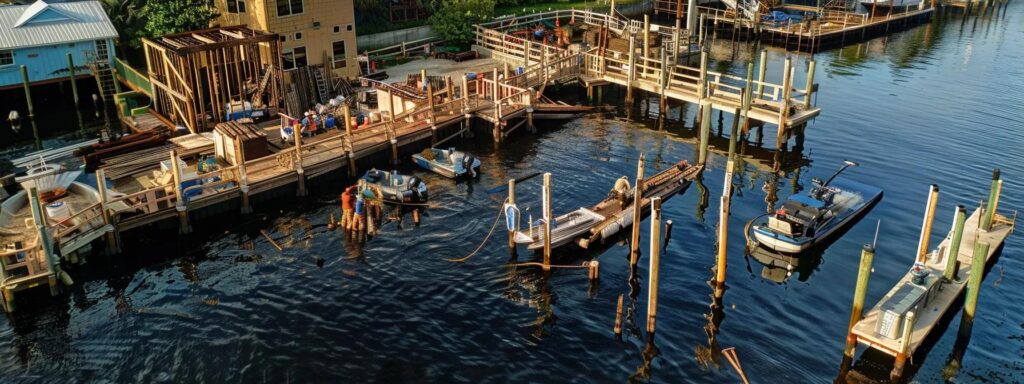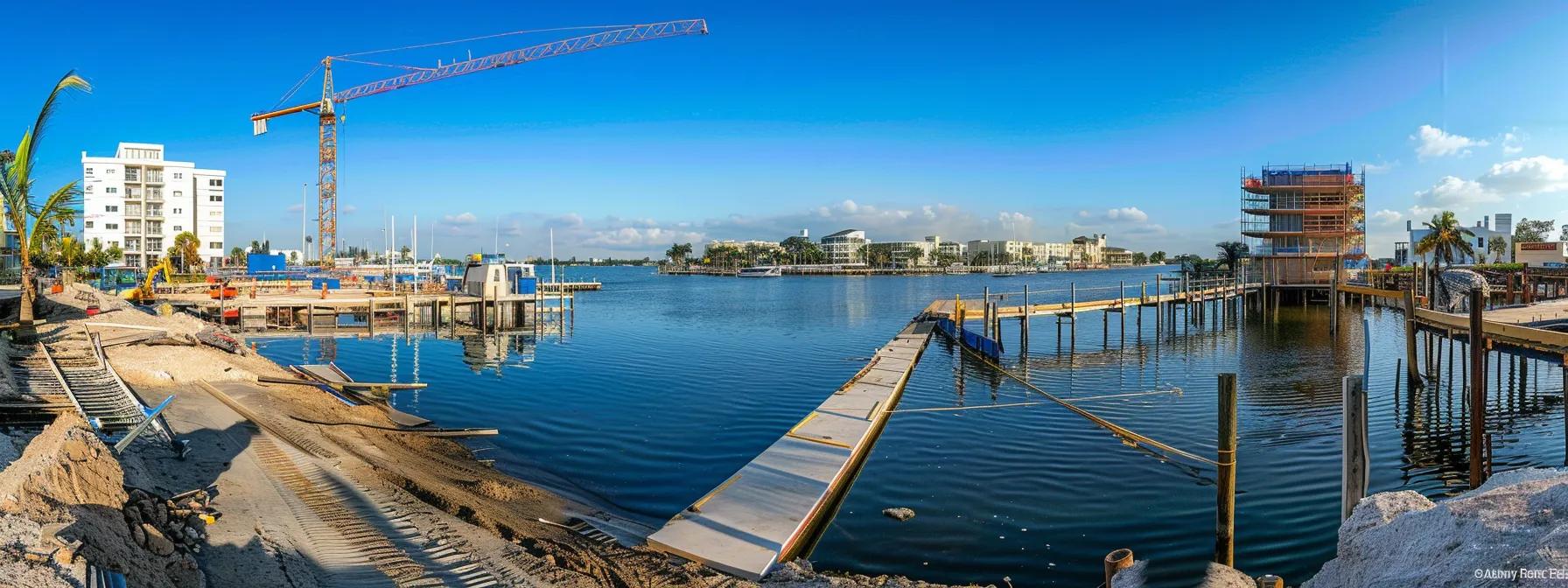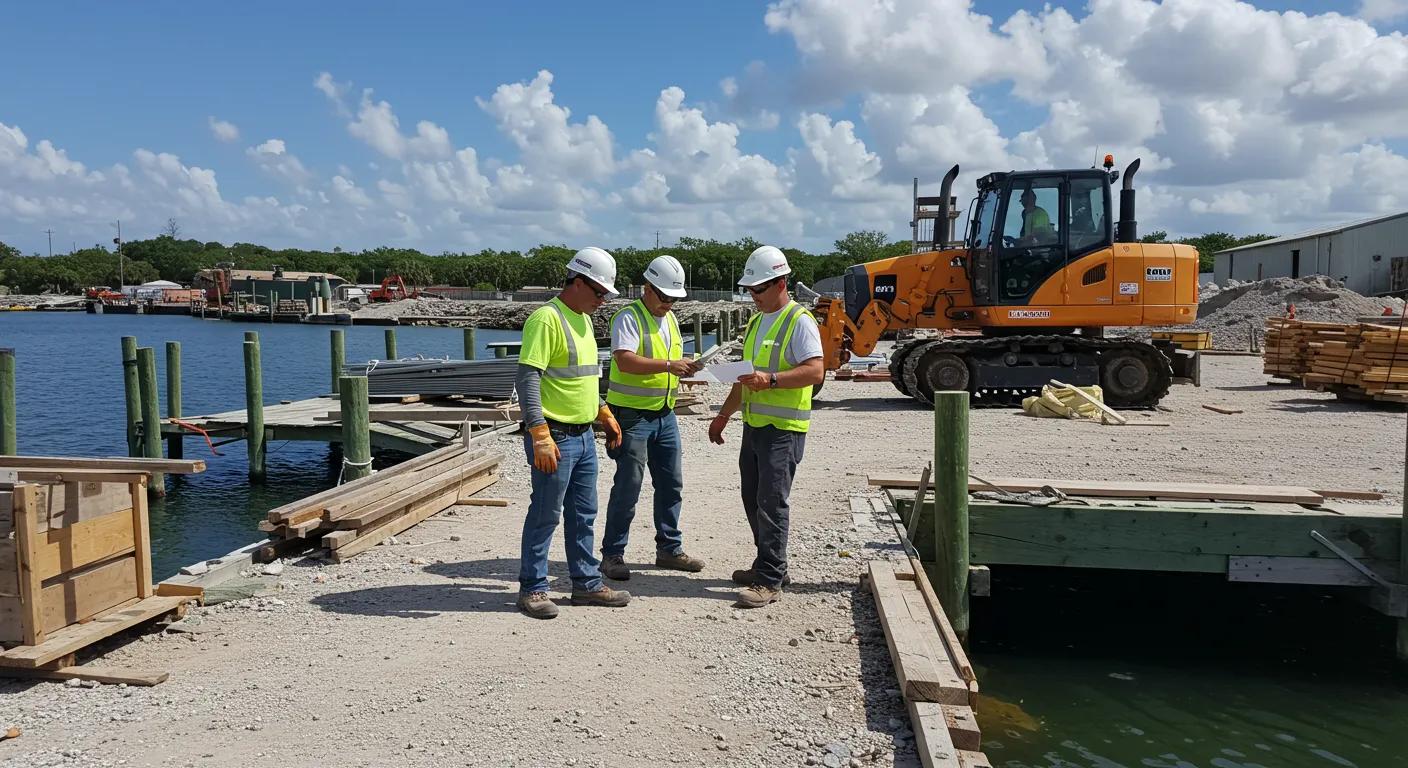How to Achieve Optimal Dock Maintenance Results
Maintaining a docking area is essential for efficiency, safety, and longevity in any waterfront operation. This article explains how scheduled inspections, quality repair materials, best cleaning practices, optimized docklighting, performance monitoring, and team training work together to manage risks, ensure compliance, and extend dock life. With decades of expertise, the following sections provide strategies to prevent corrosion and wear and tear, address hazards like sediment build-up and stormwater damage, and improve overall dock performance.
Implement Scheduled Inspections for Effective Dock Maintenance
Establishing a routine inspection process is the first step to ensuring docklongevity and safety. Regular inspections identify early signs of wear on components such as wood surfaces, metal supports, and protective coatings, preventing minor issues from evolving into hazards that could cause accidents or downtime.
Establish a Regular Maintenance Calendar for Your Docking Area
A regular maintenance calendar helps keep inspections and repairs on schedule, avoiding missed issues that compromise structural integrity. Periodic reviews—whether monthly, quarterly, or seasonally—should include visual checks for corrosion, wood decay, sediment build-up, and water quality changes. This proactive approach not only supports regulatory compliance but also reduces emergency service calls and unplanned downtime.
Identify Key Areas Requiring Frequent Inspections
Some dock areas are more vulnerable due to constant exposure to weather, water, and heavy equipment. High-risk zones include sections with frequent forklift or pallet jack traffic, loading dock levels prone to vehicular impact, and areas near dock doors. Clearly marking these zones in your schedule ensures prompt action and reduces the chance of overlooked hazards.
Use Checklists to Standardize Inspection Processes
Detailed checklists ensure every aspect of dock maintenance—from structural joints to safety barriers—is examined. Checklists reduce reliance on memory, standardize the process for new staff, and create a record for trend analysis. This systematic approach improves accuracy and helps refine maintenance strategies over time.
Report and Address Findings Promptly
Timely reporting of inspection findings is critical. Any anomalies such as cracks, moisture damage, or corrosion should be documented with photographs, dates, and detailed descriptions, then addressed immediately. Quick repairs help avert larger issues and maintain operational reliability.
Update Maintenance Strategies Based on Inspection Results
Analyzing inspection reports over time allows you to adjust maintenance strategies. Identifying recurring issues may necessitate replacing materials, upgrading finishes, or investing in new equipment. This data-driven approach enables preemptive actions to reduce overall operational risk.
Train Staff for Consistent Inspection Practices
Well-trained staff are essential for accurate inspections and timely repairs. Regular training in hazard recognition and checklist use helps maintain consistent quality. Ongoing refresher courses ensure the team stays current with the latest maintenance technologies and practices, thereby preventing accidents caused by human error.
Utilize Quality Materials for Dock Repairs

The durability of dock repairs depends largely on the quality of materials used. High-quality, marine-grade products improve structural integrity and reduce the frequency of future repairs caused by corrosion, water damage, or heavy impact.
Select Durable Materials Suitable for Marine Environments
Materials for dock repairs must withstand continuous exposure to moisture, saltwater, and weather fluctuations. For example, using stainless steel or galvanized steel for fasteners, and pressure-treated lumber or naturally rot-resistant wood like cedar, helps maintain longer service lives. Composites or engineered wood can also offer enhanced resistance to mold and moisture.
Understand the Benefits of Low-Maintenance Solutions
Low-maintenance repair materials reduce downtime and repair frequency. Coatings with self-cleaning or anti-corrosion properties, for instance, extend dock surface life, allowing you to focus more on core operations while minimizing expensive emergency repairs.
Source Materials From Reputable Suppliers
Using materials from reputable suppliers guarantees adherence to durability and performance standards. Certified vendors undergo rigorous quality tests, ensuring compliance with regulatory protocols and reducing premature material failure, which reinforces safety and operational efficiency.
Consider Environmental Impact When Choosing Materials
Opting for eco-friendly materials like recycled composites or non-toxic finishes supports sustainability and reduces hazardous waste. These solutions not only help protect water quality around the dock but also align with corporate sustainability goals by reducing stormwater pollution.
Keep Up With Innovations in Docking Materials
Ongoing innovations in dock construction continually offer more durable, efficient, and eco-friendly materials. Technologies such as self-healing coatings and smart materials that detect early wear can provide a competitive edge, keeping your dock up-to-date with modern challenges in sustainability and performance.
Regularly Assess Material Conditions and Replace as Needed
Even premium materials require periodic assessment. Scheduling evaluations to detect signs of deterioration, like corrosion or decay, ensures proactive rather than reactive repairs. This routine helps minimize unexpected downtime and supports a long-term maintenance strategy.
Apply Best Practices for Dock Cleaning Procedures
Regular dock cleaning is crucial for operational efficiency and regulatory compliance. Dirt, sediment, and biological growth like mildew not only degrade appearance but also compromise safety and material integrity.
Incorporate Eco-Friendly Cleaning Solutions Into Maintenance
Eco-friendly cleaning agents preserve dock surfaces and protect the environment. Biodegradable cleaning products designed for marine applications effectively remove oil residues, salt deposits, and biofilm without stripping protective coatings or damaging sensitive materials.
Schedule Regular Cleanings to Prevent Build-Up
A consistent cleaning schedule—daily, weekly, or monthly depending on local conditions and traffic—prevents sediment and dirt build-up that can lead to slips or hidden structural cracks. Regular cleaning enhances visual appeal and helps detect potential issues early.
Utilize Appropriate Tools for Various Dock Surfaces
Different dock materials require suitable cleaning tools. Soft-bristle brushes are ideal for delicate wooden surfaces, while high-pressure washers may be used on concrete or composites. The proper use of tools prevents damage to protective coatings and ensures a uniform level of cleanliness across the dock.
Train Staff on Safe Cleaning Techniques
Comprehensive training on cleaning protocols is essential for both safety and efficiency. Staff must be familiar with the safe use of cleaning chemicals and equipment, proper techniques for reaching difficult areas, and methods for handling slippery surfaces or hazardous spills. Proper training reduces injury risk and ensures effective maintenance.
Monitor Weather Conditions to Optimize Cleaning Timings
Scheduling cleaning during moderate weather conditions—rather than immediately after heavy rain or extreme temperatures—ensures that cleaning agents are effective and prevents issues like water accumulation that could weaken the dock’s substrate.
Establish a Record of Cleaning Activities
Keeping detailed logs of cleaning dates, methods, and observations allows for better planning of future sessions and helps track long-term trends. These records support risk management by highlighting recurring issues that may need enhanced cleaning protocols or equipment upgrades.
Optimize Dock Lighting for Safety and Functionality

Effective docklighting enhances safety, deters vandalism, and supports night operations. Optimized lighting helps prevent mishaps while ensuring compliance with regulatory standards and reducing energy consumption.
Assess Current Lighting Needs Based on Use Cases
Evaluate the dock’s lighting setup by measuring illumination levels in areas such as loading docks, walkways, and emergency exits. This assessment helps determine if current lighting meets standards for tasks ranging from heavy vehicletraffic to pedestrian movement.
Choose Energy-Efficient Lighting Options
Upgrading to energy-efficient LED fixtures reduces energy costs while providing superior brightness and longer service life. LEDs with dimming controls and adjustable color temperatures can be tailored to meet the specific needs of different dock areas, contributing to both safety and regulatory compliance.
Install Lighting in Strategic Areas for Visibility
Properly positioned lighting eliminates shadows and blind spots on the dock. Placing lights at access points, security perimeters, and high-traffic zones ensures comprehensive coverage. Supplemental lighting in areas prone to spills or accidents further boosts overall safety.
Regularly Check and Replace Burned-Out Bulbs
Routine inspections to identify and replace burned-out or malfunctioning bulbs are essential. Maintaining a log of these checks helps predict when larger overhauls might be necessary and ensures continuous, effective illumination throughout the dock area.
Implement Motion Sensor Lights for Security
Motion sensor lighting systems enhance security by activating only when movement is detected. This not only saves energy but also serves as a deterrent to unauthorized access. Integrating these sensors with centralized monitoring can provide real-time alerts, further boosting overall docksafety.
Create a Lighting Maintenance Schedule
A structured lighting schedule that outlines regular inspections, cleaning, and bulb replacements ensures that the system remains efficient and reliable. Regular updates to this schedule—based on observed performance and environmental factors—help maintain optimal lighting conditions.
Monitor Dock Performance Metrics Regularly
Performance monitoring helps identify inefficiencies, safety issues, and equipment degradation. Using key performance indicators (KPIs) leads to data-driven decisions that improve operational efficiency and reduce downtime.
Define Key Performance Indicators for Dock Operations
KPIs, such as average downtime, maintenance frequency, incident rates, and throughput, set benchmarks for evaluating dock performance. Clear definitions of these metrics guide maintenance teams and provide measurable standards for continuous improvement.
Use Technology to Track Dock Usage and Efficiency
Digital tools like sensors, automated inspection systems, and analytics platforms capture real-time data on traffic density, load times, and wear patterns. These tools enable early detection of structural issues and help adjust maintenance practices proactively.
Compare Metrics Against Industry Standards
Regularly comparing your KPIs with industry benchmarks helps identify areas for improvement. This comparative analysis can justify investments in new equipment or enhanced maintenance procedures and demonstrates that proactive strategies are yielding tangible benefits.
Adjust Practices Based on Performance Data
Analyzing metrics such as failure rates and downtime incidents enables continuous improvement. Whether it involves additional inspections or rescheduled maintenance tasks, data-driven adjustments ensure the dock remains safe, compliant, and operationally efficient.
Conduct Regular Reviews of Performance Metrics
Periodic reviews—monthly or quarterly—with cross-functional teams provide insights into maintenance effectiveness and highlight opportunities for strategic improvements. These reviews are integral to risk management and operational planning.
Involve Team Members in Performance Improvement Discussions
Regular meetings with dock operators, maintenance staff, and management encourage feedback and collaborative problem solving. This participatory approach not only enhances performance metrics but also strengthens the team’s commitment to docksafety and efficiency.
Foster Team Training and Development in Dock Operations

Effective dock maintenance depends on the skills and knowledge of the team. Continuous training ensures that all personnel understand best practices and are prepared to handle emergencies, reducing risks and improving operational performance.
Create Comprehensive Training Programs for Staff
Develop training programs that cover modern maintenance protocols, safety standards, and repair techniques. Combining theoretical modules with practical, hands-on sessions familiarizes staff with essential tools and practices while ensuring that repairs and inspections are performed efficiently.
Emphasize Safety Protocols and Emergency Procedures
Given the inherent risks in dock operations—like heavy equipment, elevated areas, and hazardous substances—regular drills and training on evacuation routes, spill containment, and emergency shutdowns are vital. These practices form the foundation of a safety-first culture.
Host Regular Workshops on Equipment Usage
Hands-on workshops on the proper use of equipment such as forklifts, dock levelers, and dock doors enhance skills and promote consistency. These sessions help staff troubleshoot common issues, perform routine checks, and execute minor repairs safely.
Encourage Continuous Learning Through Certifications
Promote certifications in occupational safety, equipment handling, and marine maintenance. Encouraging professional development ensures that staff remain qualified and updated on industry standards, supporting a culture of continuous improvement.
Provide Opportunities for Skill Development in Maintenance
Mentorship programs, cross-training, and advanced courses help staff learn about new diagnostic tools, repair methods, and risk management strategies, thereby boosting overall team performance and reliability.
Gather Feedback to Improve Training Approaches
Regular evaluations and feedback sessions allow the team to share insights on training effectiveness. This feedback loop helps tailor future training sessions to meet actual operational challenges and industry trends.
| Component | Benefit | Application | Industry Standard |
|---|---|---|---|
| Regular Inspections | Early defect detection | Maintain safety; reduce repair costs | Quarterly evaluations |
| Quality Materials | Enhanced durability | Use corrosion-resistant metals; treated wood | Marine-grade standards |
| Eco-Friendly Cleaning | Reduced environmental impact | Use biodegradable cleaning agents | EPA guidelines |
| Energy-Efficient Lighting | Lower energy consumption | Use LED and motion sensors | Energy Star rated |
| Performance Monitoring | Data-driven maintenance | Use sensors and KPIs | ISO 9001 standards |
| Team Training | Improved operational safety | Regular certifications and workshops | OSHA compliance |
The table above summarizes key components for maintaining an optimized dock. Each element is interconnected, ensuring that improvements in one area lead to overall better performance and extended dock service life.
Frequently Asked Questions
Q: What is the importance of scheduled dockinspections? A: Scheduled dock inspections enable early detection of issues such as corrosion, wear, or structural damage and prevent accidents by addressing minor problems before they escalate.
Q: How do quality materials affect dockrepairs? A: Durable, marine-grade materials like pressure-treated lumber and corrosion-resistant metals improve longevity and reduce the need for frequent repairs by withstanding harsh environmental conditions.
Q: Why are eco-friendly cleaning solutions recommended for dock maintenance? A: Eco-friendly cleaning solutions protect the dock and the environment by avoiding harsh chemicals that can damage surfaces and by supporting overall water quality and regulatory compliance.
Q: How can energy-efficient lightingoptimize docksafety? A: Energy-efficient LED systems offer bright, reliable illumination with low energy use. Features like motion sensors ensure that low-activity areas remain well-lit, reducing accident risks.
Q: What role does performance monitoring play in dock maintenance? A: KPIs and sensor data help track downtime, incident rates, and equipment efficiency. Regular reviews of these metrics guide proactive maintenance adjustments and long-term operational improvements.
Q: How does team training improve dockoperations? A: Continuous training ensures that maintenance personnel are familiar with the latest safety protocols, repair techniques, and equipment usage, thereby reducing risks and enhancing performance.
Key Takeaways: Best Practices for Effective Dock Maintenance
This article outlined the importance of regular inspections, quality repair materials, eco-friendly cleaning, optimized lighting, performance monitoring, and comprehensive team training for effective dock maintenance. Implementing these best practices minimizes risks, enhances efficiency, and extends the lifespan of your dock while ensuring regulatory compliance and sustainability. With strategic planning and continuous improvement, your dock will remain a safe, efficient, and industry-leading asset.




